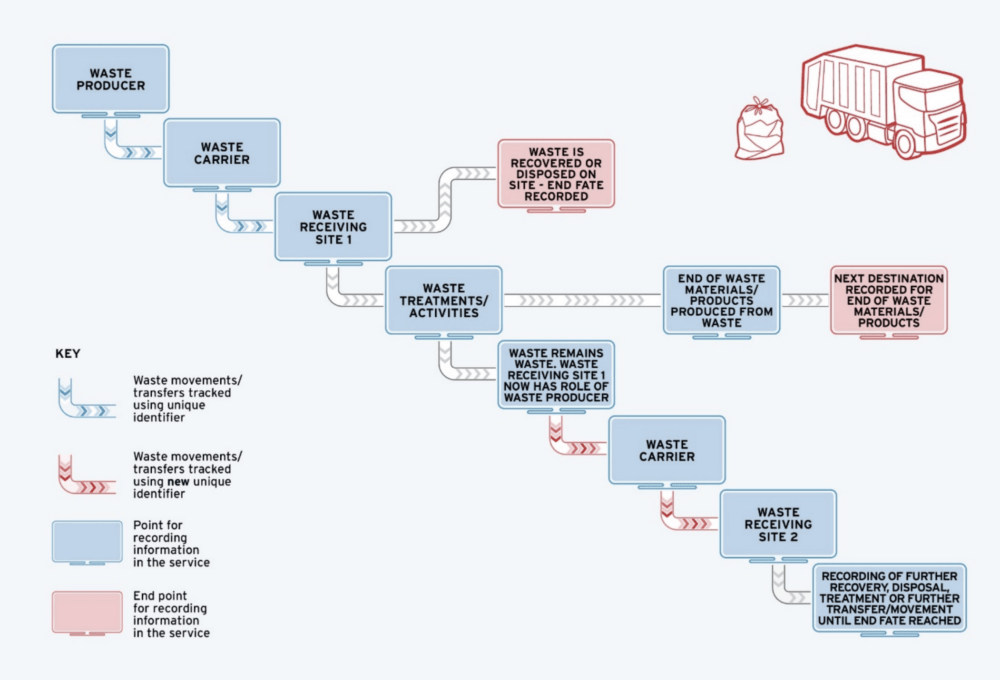See for yourself how Quartix works with our fully interactive real-time demo.

April 2025 will mark a significant shift in how UK businesses track their waste. The Mandatory Digital Waste Tracking system aims to bring accountability and real-time oversight to the entire waste lifecycle—from pickup through to final treatment. Whether you operate a small service outfit or manage a large fleet, it pays to understand the new requirements well before the deadline.
Below is a straightforward breakdown of the key changes, along with insights on how vehicle tracking can complement your overall workflow.
1. Why These Changes?
The government wants more accurate, real-time data on waste movements to reduce illegal dumping, improve environmental outcomes, and cut through messy, paper-based processes. This shift to a centralised digital platform means:
- No More Physical Paperwork: Traditional waste transfer notes and consignment notes will be phased out in favour of a single digital record.
- Nationwide Consistency: The UK, Scottish, and Welsh governments—alongside Northern Ireland’s DAERA—are collaborating, so the entire nation follows uniform guidelines.
Key Takeaway: If your business generates or handles controlled waste, you’ll need to enter details (quantities, types of waste, destination, etc.) into the new system.
2. What Businesses Must Do
1. Register for the System
- Registration begins in 2024. By April 2025, if you’re generating, handling, or transporting waste, you must be enrolled.
- This isn’t optional—if you’re in the waste chain, you’re likely affected.
2. Digitise All Waste Movements
- Hazardous, non-hazardous, and recyclable materials must be logged digitally.
- Any time waste changes hands—moving off-site, switching operators, or being transferred to another location—it goes into the system.
3. Train Relevant Staff
- From site managers to drivers, anyone involved in waste records will need to know how to input data correctly.
- Mistakes or delays in updating the system could lead to fines or investigations.
4. Stay Compliant with Updated Regulations
- Inspectors and regulators can now spot data discrepancies more easily.
- If your records don’t match reality, enforcement actions could follow.
3. Exemptions & Special Cases
- Animal By-Products: Might remain optional to track initially, but the government may add functionality later.
- Extractive Wastes (like mining or quarry materials): Not required unless they leave the site.
- Household, Commercial & Industrial: Generally need tracking unless specifically exempt.
- Green List Waste: Even though you’ll still have Annex VII documentation, you’ll also need to input details into the new digital platform.
Pro Tip: Check the guidelines closely. There are various small carve-outs (like litter collection and some local authority processes), but for the majority of businesses handling controlled waste, digital logging will be the norm.
5. Potential Risks & Penalties
If you ignore or postpone compliance:
- Significant Fines: Variable monetary penalties may have no upper limit, especially outside Scotland.
- Reputational Harm: Environmental compliance is a key concern for customers, investors, and regulators.
- Operational Disruption: Scrambling to catch up after the April 2025 deadline could cause major headaches.
By training staff early and setting up consistent processes for data entry, you can avoid panic and potential penalties.
6. Practical Steps to Prepare Now
1. Review Your Waste Streams
- Identify which types of waste your business produces or handles. Make a note of any that might be exempt.
2. Set Up a Digital Workflow
- Plan how you’ll capture waste data in real time (or as close to it as possible). If you’re switching from paper, start small with pilot testing.
3. Coordinate with Your Carriers
- Talk to your waste transport partners. They’ll likely need to collaborate on logging data. Make sure everyone’s on the same page.
4. Consider a Fleet Tracking Tool
- Even though it’s not legally required, telematics can plug knowledge gaps about vehicle movements. The extra layer of oversight can save you time cross-checking records.
7. The Bottom Line
By April 2025, the UK’s waste management landscape changes fundamentally—any business dealing with controlled waste must document every movement through a unified digital service. It’s a leap forward in transparency and accountability, but also a challenge if you rely on outdated systems.
While vehicle tracking and telematics aren’t mandated for compliance, they can greatly enhance your day-to-day visibility. Quartix offers real-time tracking and comprehensive reporting—tools that make it easier to coordinate your waste movements, train staff on best practices, and verify your logs. No, it won’t fulfil the digital waste logging requirement directly, but it complements it by giving you a clear, accurate view of your fleet’s activity.
Curious how Quartix might fit into your compliance strategy? Reach out to our team for a no-obligation chat about boosting efficiency and oversight in your waste operations.
Disclaimer: This blog post provides general information only and does not constitute legal advice. For detailed guidance on mandatory digital waste tracking, consult official regulations or a qualified advisor.

